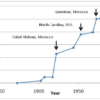To “cry poor mouth” is an expression used to habitually complain about a lack of money. A literal poor mouth, however, represents one of the most widespread global diseases: tooth decay. Cavities resulting from poor oral health can drive everything from emotional issues to low self-esteem and health concerns.
Even more critical is the socioeconomic impact of tooth decay. Cavities are a “hidden cost” across a person’s lifespan. They can affect the ability of children to learn, result in absenteeism and a loss of productivity for employees and employers, and increase health costs for retirees.
Untreated tooth decay can result in health complications including poor nutrition, if it is painful to chew; severe pain; and a higher risk of drug abuse and heart disease, including an infection of the heart called subacute bacterial endocarditis. This heart condition, caused primarily by Streptococcal bacteria normally found in the mouth, can increase with tooth decay, move into the bloodstream and infect the heart valves, leading to loss of function and, while quite rare, can even lead to death. More recently, reports have documented that untreated dental cavities can result in brain infections and death.
What can you do to safeguard your teeth from decay? Are cavities inevitable? Does your genetic makeup determine how you are able to fend off decay? The answers, as you might guess, are complex.
Who is at risk from tooth decay?
National data show that more than 45% of children ages 2-19 have cavities, and nearly 17% of them go untreated. For adults, 92% of people ages 20-64 have experienced tooth decay, with more than 30% of these cavities left untreated. These statistics can be attributed to several intersecting factors.
Pawel Czerwinski/Unsplash, CC BY-ND
First, some people believe that cavities are not a big deal and losing teeth from decay is inevitable. Second, dental insurance is not widely offered with health insurance, and, while not overly expensive to purchase, more than 60% of the cost of dental procedures is not covered and has to be paid by an individual.
The exception is children on Medicaid, which generally covers the cost of dental treatments. However, Medicaid and Medicare have very limited coverage for dental procedures for adults and vary tremendously from state to state.
Finally, there continues to be a challenge in access to care that includes a national lack of dentists, uneven distribution of dentists in counties and states and particularly rural areas, substantial out-of-pocket costs and the critical role patients plan in maintaining good oral health.

Marcos Paulo Prado/Unsplash, CC BY-ND
A recipe for cavities
There are four underlying biological features of cavities, beginning with the microbiome or the bacteria that live in the mouth. What a person eats also matters: How much and how often someone eats carbohydrates will determine how much acid will be created, since acid in the mouth dissolves the enamel covering that protects the teeth. The chemistry of saliva that bathes the oral cavity and protects teeth against cavities is another important aspect of health. And finally, genetics contribute to the structural characteristics of teeth and the ability to withstand tooth decay.
Since the initial reports were published in 2008 from the Human Microbiome Project, supported by the National Institutes of Health, much has been learned about health and disease in relation to the microbiome of the mouth. One of the most important insights is the complex set of bacteria related to cavities, especially severe ones. Molecular microbiology studies have provided new evidence about the biology and ecology of tooth decay and the pathogens that have led to new strategies and targets for therapeutics.
What causes decay?
The bacteria or microbiome in families has been shown to be related to cavities, the type of tooth, and their structure in the mouth. The bacteria of tooth decay colonize the oral cavity early in life and are transmitted from mother to baby. What may tip the balance into decay is diet, which plays a central part in how tooth decay is expressed.
Bacteria ferment a wide array of carbohydrates, like sugar and high fructose corn syrup, to produce acid. This acid accumulates in the bacterial biofilms on the teeth, resulting in cavities. Acid-producing and acid-loving bacteria are the primary culprits in dissolving the enamel, which protects the tooth. Once the enamel is dissolved, the underlying portion of the tooth, the dentin, is softer and more easily destroyed by the acid, thus leading to wider and deeper expansion of the cavity.

Eddie Kopp/Unsplash, CC BY-ND
To offset this corrosion, recent therapeutics containing acid buffering agents, such as arginine, are included in toothpastes and mouth rinses to combat the disease. Evidence also suggests that other dietary micronutrients, such as vitamin D, can lower the risk for cavities. These findings emphasize a better understanding of the biology of this global disease for improved prevention and treatment of cavities.
The role of saliva
It is estimated that one person swallows approximately a liter of saliva each day. The flow of saliva is substantially decreased while sleeping and is increased with eating or even when thinking about food. This mechanical cleansing is critical for the health of the mouth. However, it is clear that “normal” saliva production and salivary flow varies across the population. Lower salivary flow is considered a risk for dental caries.
Importantly, internal and external factors can abnormally impact salivary flow. This can include radiation therapy, systemic diseases like diabetes, autoimmune diseases that affect the salivary glands, a wide array of pharmaceuticals and aging.
New research firmly supports a genetic contribution to the risk and development of cavities. The likely genetic influence is the characteristics of teeth and the ability of saliva to protect your mouth. It is clear that the microbiome in your mouth is critical in driving an environment where cavities can develop.
[You’re smart and curious about the world. So are The Conversation’s authors and editors. You can read us daily by subscribing to our newsletter.]



